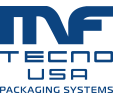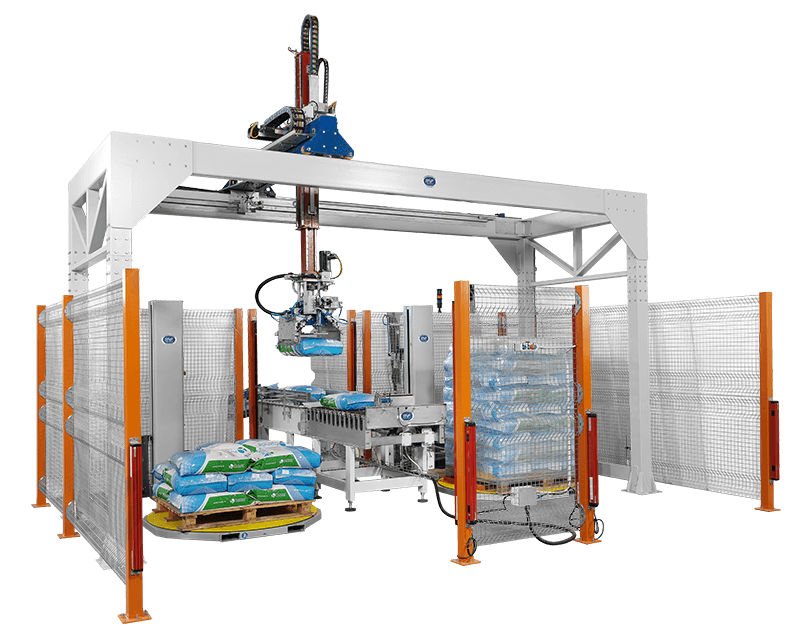Choosing the right palletizer is essential to improving your business's competitiveness.
Efficiency and productivity in today’s manufacturing processes also depend on the proper and effective handling of goods.
The palletizer, which handles the stacking of products on pallets, is an integral part of logistics processes.
It is one of the key technologies driving the transformation of current manufacturing processes.
In fact, it plays a crucial role in supply-chain management and the automation of end-of-line packaging.
However, with a wide range of solutions available on the market, selecting the ideal model requires careful evaluation.
MF TECNO has decades of experience in designing a wide variety of palletizers and anthropomorphic robots.
In this guide, we will help you analyze and evaluate the factors and elements to consider when choosing the right model for your needs.
We will cover:
- What a palletizer is and how it works
- The benefits of palletizers
- Key factors to consider when choosing a palletizer
- Different types of palletizers
- Required investment
- Supplier evaluation
What is a palletizer and how does it work
A palletizer robot is designed to automate the storage phase of pre-packaged products on pallets, following a predefined pattern.
It organizes and stacks multiple products into a single load, making handling, storage, and shipping more efficient.
It can handle packages, boxes, bundles, or bottles, improving overall warehouse operations.
Its operation involves receiving products and systematically stacking them on a pallet according to a preset layout.
The ability to configure different palletizing patterns and handle various product types optimizes the packaging process.
Benefits of palletizers
Automating production processes and incorporating a palletizer robot into your warehouse brings numerous benefits, including:
- Increased efficiency and productivity compared to manual labor, with faster, more consistent operation and significantly reduced downtime.
- Cost savings due to reduced reliance on manual labor and fewer errors from repetitive, strenuous tasks.
- Improved safety by reducing workplace injuries and reallocating employees to higher-value tasks.
- Space optimization through precise and uniform stacking systems that maximize space and reduce transportation costs.
- Enhanced quality control and more effective product handling.

Key factors to consider when choosing a palletizer
There are several elements to consider when selecting a palletizer.
These evaluations will lead to choosing one model over another based not only on current production needs but also on future growth prospects.
Key factors to consider include:
- Production volume and speed
- Product characteristics
- Available space
- Pallet configuration
- Safety requirements
- Required investment
- Integration with existing equipment
Production volume and speed
The palletizer must align with production needs and the volume of goods being produced.
Failing to meet production requirements can lead to bottlenecks.
Therefore, the choice should take into account both current and future production levels.
Automatic palletizing systems are ideal for high production demands.
Semi-automatic or manual systems, on the other hand, are better suited for handling smaller volumes.
Product characteristics
Different types of products require different palletizer models. Size, shape, weight, and material type are all factors that influence the choice.
Products with unique shapes, dimensions, fragility, or weight often require custom solutions.
Available space
Available space is another key element that significantly impacts the choice of palletizing model.
A lack of space can greatly limit options, so the decision must also consider the surface area needed around the equipment.
Pallet configuration
To facilitate the movement of goods, various pallet configurations are available. Some industries require specific palletizing and stacking configurations to maximize space and ensure productivity.
Defining the palletizing layout best suited to your needs can reduce the complexity of palletizing systems.
Safety requirements
It’s important to consider the presence of adequate safety measures and accident-prevention features, such as stop systems and sensors capable of detecting and preventing potential anomalies and incidents.
Required Investment
Another key factor in choosing a palletizer is the investment cost. Specifically, the estimated budget should take into account:
- Initial investment: This includes the cost of the equipment, installation, and any necessary modifications.
- Operating costs: This category includes energy consumption, maintenance, and labor.
- Return on Investment (ROI): A comprehensive evaluation of the long-term economic impact of the investment, not just the short-term benefits.
Integration with Existing Equipment
Another crucial factor is the ability to integrate palletizer robots with existing packaging and primary packing systems.
This integration can optimize and enhance the efficiency of the entire production process.

Different Types of Palletizers
Once specific production requirements are defined, it’s time to evaluate and analyze which type of palletizer is the most suitable.
Each model has characteristics that make it ideal for certain applications.
Among the various types and models of palletizers, MF TECNO offers:
- Cartesian pallettizer
- Top-loading pallettizer
Cartesian Palletizer
This model operates via a mechanical arm that performs vertical, horizontal, diagonal, and rotational movements along the four Cartesian axes.
It is an extremely precise and high-performance option. MF TECNO’s Cartesian models are designed for medium- to high-production operations.
Top-Loading Palletizer
Top-loading palletizers are ideal for creating stable pallets and achieving high production speeds.
Products are transported to the pallet formation platform and pickup conveyor via a conveyor belt and bag-centering belt.
Supplier Evaluation
Choosing the right supplier is just as important as selecting the model that best meets your needs.
When researching a manufacturer of palletizers, you should evaluate:
- Industry experience and references:
Opting for a company with proven experience and significant references in the sector is a key factor and an element of reliability. - Support and assistance:
Another important factor is the ability to provide fast, precise customer support and service. This includes consistent assistance during project evaluations as well as post-sale support. - Customization:
Selecting the right supplier also involves assessing their ability to design custom systems tailored to meet your specific needs and requests.
We have decades of experience in the production and development of palletizer robots, both as standalone projects and as part of complete packaging systems. Choosing us means partnering with a solid company that places quality and customer care at the forefront of its business.
Each component of our machinery is produced in-house, ensuring reliable and prompt customer service.
 FREE QUOTE
FREE QUOTE  Machinery
Machinery Open Mouth Bagging machines
Open Mouth Bagging machines Vertical packaging machines
Vertical packaging machines FREE QUOTE
FREE QUOTE 


 FREE QUOTE
FREE QUOTE 
 FREE QUOTE
FREE QUOTE 























 Request information
Request information 
